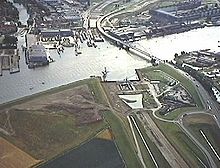Van der Giessen-De Noord
The Dutch shipbuilding company Van der Giessen-De Noord NV existed from 1883 to 2003. It operated shipbuilding and mechanical engineering with shipyards in Krimpen aan den IJssel and Alblasserdam .
history
prehistory
The company's roots go back to before 1810; At that time, Arie van der Giessen was working as a manager at the wooden shipyard of his uncle Arie van den Hoek jr. in Stormpolder . In 1820, the thirty-year-old Arie van der Giessen inherited his uncle's shipyard and continued to operate it with around ten journeymen. In the main, ship repairs were carried out and individual inland vessels built for their own account, which were rented out.
When Arie van der Giessen died in 1840, shipbuilding fell into disrepair. The shipyard was continued under the management of the widow Neetlje Pannevis with Arie's sons Arie and Cornelis. The situation improved and in 1853 construction began on the sea-going barque Vriendentrouw . However, differences of opinion between Arie and Cornelis led to the division of the company in 1859. Cornelis took over the eastern part of the shipyard with two slipways and a forge, which he continued under the name "De Hoop" ; Arie kept the western part with a slipway.
At “De Hoop” they adjusted to the construction of seagoing sailing ships, but continued to build barges. A few bad years followed, as the Netherlands was hit by an economic crisis emanating from Great Britain. It was not until 1862 that “De Hoop” received its first order to build a large ship, the frigate Zuid-Holland . At 1,292 tons, she was the largest ship the shipyard had ever built.
founding
The foundation stone of the actual company Van der Giessen-De Noord was laid by Cornelis in 1883 when he bought a shipyard in the west of Stormpolder, which was named "de Nijverheid". In the beginning, barges were repaired there. After Cornelis' sons Jan and Arie joined the company, the premises were enlarged and the company was finally provided with the necessary equipment for building iron ships by 1892. In 1895 Cornelis van der Giessen resigned and left the management of the company to his sons Jan and Arie, which was then renamed Cornelis van der Giessen & Zonen .
While “de Nijverheid” was next provided with a ship's forge, “De Hoop” was prepared for the construction of iron ships up to a length of 63 meters. By 1900 the company had around 150 employees. In 1908, Jan and Arie also acquired their uncle Arie's shipyard, reversing the split of the original company. Until 1914, numerous inland and individual seagoing ships were built for German accounts. After the outbreak of World War I, the focus was increasingly on building seagoing ships. The management of the company has meanwhile been placed in the hands of Arie's son, Cornelis van der Giessen, and Pieter Cornelis, Jan's son. These received their training at the higher shipbuilding school in Bremen and the William Hamilton & Company shipyard in Glasgow.
Post-war years
In 1962 the NVC van der Giessen & Zonen's Scheepswerven in Krimpen on the IJssel merged with the “De Noord” shipyard from Alblasserdam to form Van der Giessen-De Noord . From 1968 the shipyard began using computers for administration and construction and at the end of the 1970s the company built a shipbuilding hall 264 meters long, 97 meters wide and 52 meters high in Krimpen for 87 million guilders, at the time the largest covered shipbuilding slipway in the world.
At the end of the Cold War , the number of new construction orders decreased, especially the naval orders. Nevertheless, in 1990 a new shipbuilding hall was built at the “De Noord” shipyard in Alblasserdam, which was sold to the yacht building company Oceanco due to a lack of new construction contracts . "De Noord" then only acted as a repair yard and continued to build sections for the main company in Krimpen aan de IJssel.
In the last decades of the 20th century Van der Giessen-De Noord concentrated particularly on the construction of fast RoRo / passenger ferries and the conversion and maintenance of naval ships. Furthermore, Van der Giessen-De Noord Pipe Systems was operated , which manufactured sophisticated shipbuilding and offshore pipe systems, an airport department that manufactured and installed airport installations and facilities such as check-in and security systems, as well as other particularly specialized airport equipment. In addition, there was a real estate subsidiary and a subsidiary that was involved in the construction of single-family houses. Civil shipbuilding with pipe system construction was responsible for around 94% of sales in 1996, naval shipbuilding for 4% and the airport division for 2%.
The last few years
Van der Giessen-De Noord was taken over by IHC-Caland (later SBM Offshore ) in 1997 , but continued under its own name. Three years later, plans were made to expand the shipbuilding company to Alblasserdam-Süd, but the construction of the section remained . From the same year 2000, the main shipyard received no further shipbuilding aid and no new construction contracts. After the last new building, the Mont St. Michel , was delivered to the shipping company Brittany Ferries in December 2002 , NV Van Der Giessen-De Noord went into liquidation in October 2003.
The shipyard today belongs to the steel construction company Hollandia .



